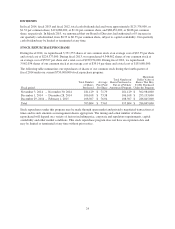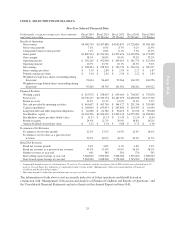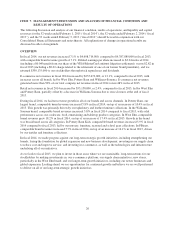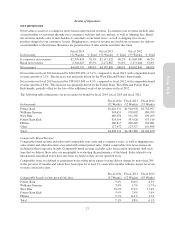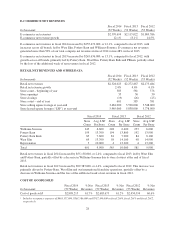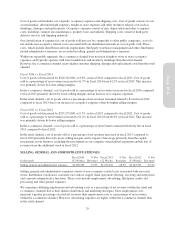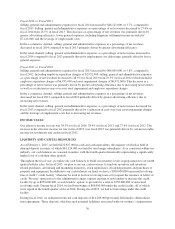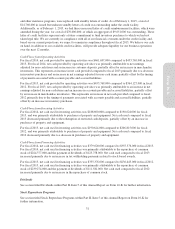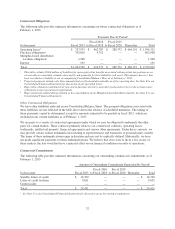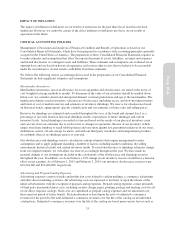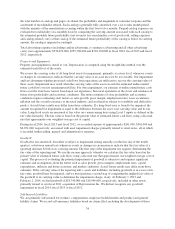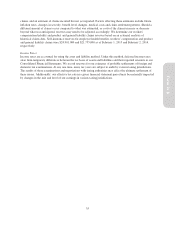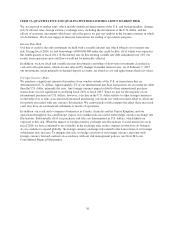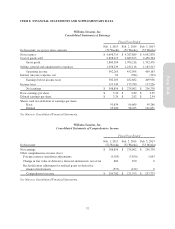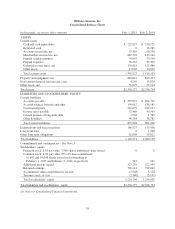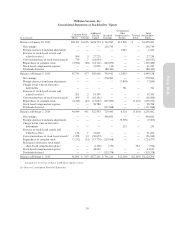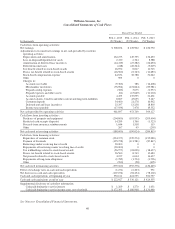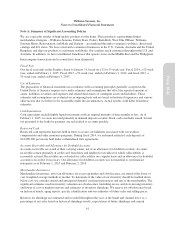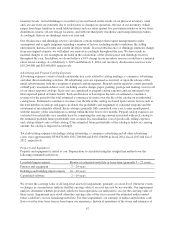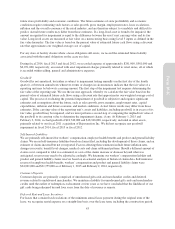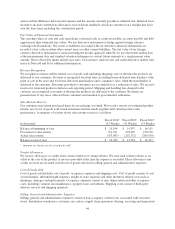Pottery Barn 2014 Annual Report Download - page 48
Download and view the complete annual report
Please find page 48 of the 2014 Pottery Barn annual report below. You can navigate through the pages in the report by either clicking on the pages listed below, or by using the keyword search tool below to find specific information within the annual report.the total number of catalogs and pages circulated, the probability and magnitude of consumer response and the
assortment of merchandise offered. Each catalog is generally fully amortized over a six to nine month period,
with the majority of the amortization occurring within the first four to five months. Prepaid catalog expenses are
evaluated for realizability on a monthly basis by comparing the carrying amount associated with each catalog to
the estimated probable future profitability (net revenues less merchandise cost of goods sold, selling expenses
and catalog-related costs) of that catalog. If the estimated future profitability of the catalog is below its carrying
amount, the catalog is impaired accordingly.
Total advertising expenses (including catalog advertising, e-commerce advertising and all other advertising
costs) were approximately $330,070,000, $325,708,000 and $318,338,000 in fiscal 2014, fiscal 2013 and fiscal
2012, respectively.
Property and Equipment
Property and equipment is stated at cost. Depreciation is computed using the straight-line method over the
estimated useful lives of the assets.
We review the carrying value of all long-lived assets for impairment, primarily at a store level, whenever events
or changes in circumstances indicate that the carrying value of an asset may not be recoverable. Our impairment
analyses determine whether projected cash flows from operations are sufficient to recover the carrying value of
these assets. Impairment may result when the carrying value of the asset exceeds the estimated undiscounted
future cash flows over its remaining useful life. For store impairment, our estimate of undiscounted future cash
flows over the store lease term is based upon our experience, historical operations of the stores and estimates of
future store profitability and economic conditions. The future estimates of store profitability and economic
conditions require estimating such factors as sales growth, gross margin, employment rates, lease escalations,
inflation and the overall economics of the retail industry, and are therefore subject to variability and difficult to
predict. Actual future results may differ from those estimates. If a long-lived asset is found to be impaired, the
amount recognized for impairment is equal to the difference between the asset’s net carrying value and its fair
value. Long-lived assets are measured at fair value on a nonrecurring basis using Level 3 inputs as defined in the
fair value hierarchy. The fair value is based on the present value of estimated future cash flows using a discount
rate that approximates our weighted average cost of capital.
During fiscal 2014, fiscal 2013 and fiscal 2012, we recorded expense of approximately $241,000, $561,000 and
$6,071,000, respectively, associated with asset impairment charges primarily related to retail stores, all of which
is recorded within selling, general and administrative expenses.
Goodwill
Goodwill is not amortized, but rather is subject to impairment testing annually (on the first day of the fourth
quarter), or between annual tests whenever events or changes in circumstances indicate that the fair value of a
reporting unit may be below its carrying amount. The first step of the impairment test requires determining the
fair value of the reporting unit. We use the income approach, whereby we calculate the fair value based on the
present value of estimated future cash flows using a discount rate that approximates our weighted average cost of
capital. The process of evaluating the potential impairment of goodwill is subjective and requires significant
estimates and assumptions about the future such as sales growth, gross margins, employment rates, capital
expenditures, inflation and future economic and market conditions. Actual future results may differ from those
estimates. If the carrying value of the reporting unit’s assets and liabilities, including goodwill, is in excess of its
fair value, goodwill may be impaired, and we must perform a second step of comparing the implied fair value of
the goodwill to its carrying value to determine the impairment charge, if any. At February 1, 2015 and
February 2, 2014, we had goodwill of $18,740,000 and $18,946,000, respectively, included in other assets,
primarily related to our fiscal 2011 acquisition of Rejuvenation Inc. We did not recognize any goodwill
impairment in fiscal 2014, fiscal 2013 or fiscal 2012.
Self-Insured Liabilities
We are primarily self-insured for workers’ compensation, employee health benefits and product and general
liability claims. We record self-insurance liabilities based on claims filed, including the development of those
34


